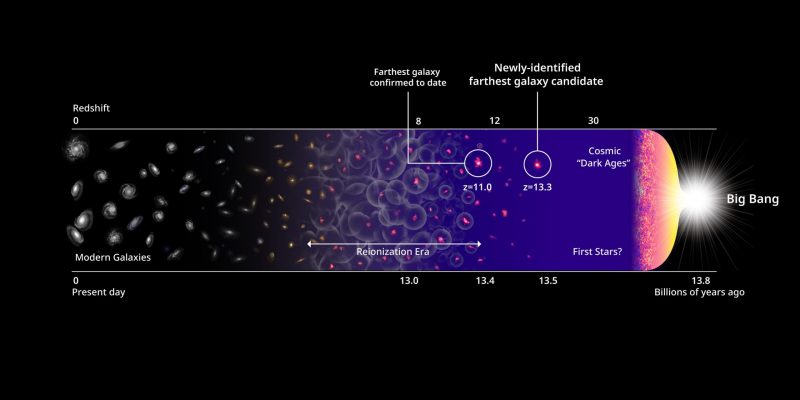
Astronomers said on April 7, 2022, that they’ve discovered the farthest astronomical object yet observed. They believe this object is a galaxy, and, if so, it’s the most distant one currently known. The object carries the label HD1. It lies 13.5 billion light-years away. Because light doesn’t travel infinitely fast, but takes time to travel across space to us, looking out into space is the same as looking back in time. So, these astronomers said, we’re looking at this object as it existed in the distant past, just 300 million years after the Big Bang in which our universe was born.
Yuichi Harikane of the University of Tokyo discovered the galaxy. He said:
It was very hard work to find HD1 out of more than 700,000 objects. HD1’s red color matched the expected characteristics of a galaxy 13.5 billion light-years away surprisingly well, giving me goosebumps when I found it.
The scientists published their study of this new object, HD1, in the peer-reviewed journal Monthly Notices of the Royal Astronomical Society Letters on January 3, 2022, and the peer-reviewed Astrophysical Journal on December 16, 2021.
Farthest object and most distant galaxy
An international team of astronomers used an array of telescopes to spot this distant object. The Subaru Telescope, VISTA Telescope, UK Infrared Telescope and Spitzer Space Telescope all stared at the same spot in space for a combined total of 1,200 hours.
Once they spotted the dim red object seen in the image above, they made followup observations with the Atacama Large Millimetre/submillimetre Array (ALMA) to confirm the distance. The previous record-holder for most distant object went to GN-z11, a galaxy we see in the direction of Ursa Major. With a redshift of z = 11.09, GN-z11 is 13.4 billion light-years away. It exists some 400 million years after the Big Bang. HD1 is 100 million light-years further away than GN-z11.

An ultraviolet-bright object
Scientists believe this object, the furthest ever seen in space, is a galaxy in the infant universe. We can see the object because it’s extremely bright in ultraviolet (UV) wavelengths. Why is it so bright in ultraviolet light? Astronomers have two ideas.
Idea 1: Population III stars in the most distant galaxy
First, the galaxy may be forming stars at furious rate. These could be some of the universe’s very first stars. Astronomers would categorize these early stars as Population III stars. Population III stars are a hypothetical category because they’ve never been observed existing so far back in time. They would have been extremely massive, hot, luminous stars that first created chemical elements heavier than hydrogen.
Scientists estimate that HD1 is forming more than 100 stars every single year. This rate is at least 10 times higher than a normal starburst galaxy. This is one of the reasons they think the galaxy is not forming “normal” stars.
Lead author Fabio Pacucci of Harvard University and Smithsonian Astrophysical Observatory said:
The very first population of stars that formed in the universe were more massive, more luminous and hotter than modern stars. If we assume the stars produced in HD1 are these first, or Population III, stars, then its properties could be explained more easily. In fact, Population III stars are capable of producing more UV light than normal stars, which could clarify the extreme ultraviolet luminosity of HD1.
Idea 2: A supermassive black hole in the most distant galaxy
Second, the galaxy may be home to a supermassive black hole. It would have to be about 100 million times the mass of our sun. Compare that to the supermassive black hole at the center of the Milky Way, which is about 4 million times the mass of our sun.
The supermassive black hole would be eating surrounding material, and, in the process, emitting high-energy photons. If it is a supermassive black hole, it would be the earliest ever seen, existing much closer in time to the Big Bang compared to the current record-holder.
Avi Loeb of Harvard commented:
Forming a few hundred million years after the Big Bang, a black hole in HD1 must have grown out of a massive seed at an unprecedented rate. Once again, nature appears to be more imaginative than we are.
Understanding an object from across the universe
Pacucci explained how difficult it is to analyze an object that exists so far away. He said:
Answering questions about the nature of a source so far away can be challenging. It’s like guessing the nationality of a ship from the flag it flies, while being faraway ashore, with the vessel in the middle of a gale and dense fog. One can maybe see some colors and shapes of the flag, but not in their entirety. It’s ultimately a long game of analysis and exclusion of implausible scenarios.
The team hopes to use the Webb telescope to make follow-up observations and confirm HD1’s identity as the most distant galaxy yet discovered.
Bottom line: An international team of scientists have discovered the farthest astronomical object ever seen. They believe HD1 – as they’ve named it – is the most distant galaxy yet known.
Source: A Search for H-Dropout Lyman Break Galaxies at z~12-16
Source: Are the Newly-Discovered z~13 Drop-out Sources Starburst Galaxies or Quasars?











